EDF Bundle
Can EDF Power the Future?
Electricite de France (EDF), a titan in the global energy market, is charting a course through a rapidly changing landscape. From its roots in post-war France, EDF SWOT Analysis reveals how the company has evolved into a multinational powerhouse, navigating the complexities of the energy transition. This article delves into EDF's ambitious growth strategy and examines its future prospects in an era defined by decarbonization and technological innovation.
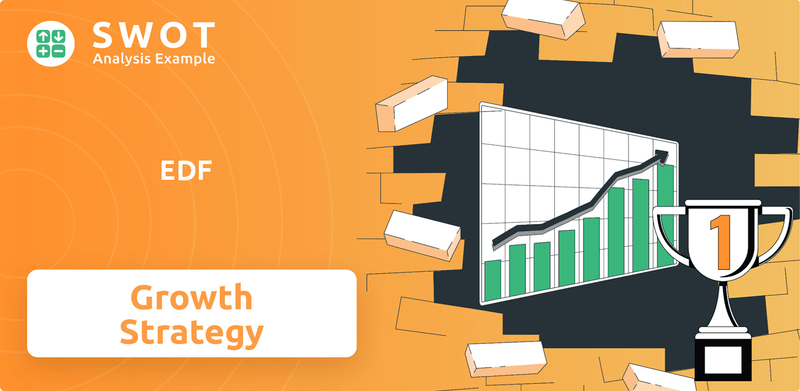
Understanding the EDF company analysis is crucial for anyone tracking energy market trends. The company's strategic plan for expansion is heavily influenced by the renewable energy sector and its commitment to sustainability. This piece will dissect EDF's strategic initiatives, financial performance, and its approach to both the challenges and opportunities presented by the evolving global energy landscape, offering a comprehensive view of EDF's future prospects.
How Is EDF Expanding Its Reach?
The expansion initiatives of Electricite de France (EDF) are primarily focused on strengthening its core businesses and capitalizing on opportunities within the energy transition. This strategic direction is crucial for navigating the evolving energy market trends and ensuring long-term growth. The company's approach involves significant investments in renewable energy and strategic partnerships, positioning it to meet the growing demand for sustainable energy solutions. This strategy is vital for EDF's future prospects.
A key element of EDF's growth strategy is the substantial investment in renewable energy sources, particularly in offshore wind and solar power. The company is aligning its efforts with global decarbonization initiatives. EDF aims to increase its renewable energy capacity significantly by 2030, targeting a net installed renewable capacity of 50 GW.
Furthermore, EDF is pursuing strategic acquisitions and partnerships to enhance its market presence and technological capabilities. This includes collaborations for developing advanced nuclear technologies, such as small modular reactors (SMRs), which are seen as a vital component of future low-carbon energy mixes. Diversification of revenue streams is also being pursued through the expansion of energy services, including smart grid solutions, energy efficiency programs, and electric vehicle charging infrastructure.
EDF Renewables is actively developing projects worldwide, expanding its global footprint. In 2024, this expansion included new projects in the US and Europe. The company's focus is on increasing its renewable energy capacity to meet its 2030 targets. This is a key aspect of the EDF growth strategy.
EDF is forming strategic alliances to enhance its technological capabilities, particularly in advanced nuclear technologies like SMRs. These partnerships are crucial for diversifying its energy portfolio. These collaborations are essential for EDF's future prospects.
EDF is exploring new geographical markets for its expertise in nuclear power plant construction and operation. Ongoing discussions and projects are underway in several countries. This international expansion strategy aims to broaden EDF's market share.
EDF is expanding its energy services, including smart grid solutions and electric vehicle charging infrastructure. These initiatives aim to capture new customer segments. This diversification supports EDF's long-term growth potential.
EDF's expansion strategy is multifaceted, focusing on renewable energy, strategic partnerships, and geographical diversification. These initiatives are designed to adapt to the energy transition and secure EDF's position in the global energy market. For more details, you can also explore the Target Market of EDF.
- Significant investments in renewable energy, targeting 50 GW of net installed renewable capacity by 2030.
- Strategic acquisitions and partnerships to enhance market presence and technological capabilities.
- Expansion of energy services, including smart grids and electric vehicle charging infrastructure.
- Exploration of new geographical markets for nuclear power expertise.
EDF SWOT Analysis
- Complete SWOT Breakdown
- Fully Customizable
- Editable in Excel & Word
- Professional Formatting
- Investor-Ready Format
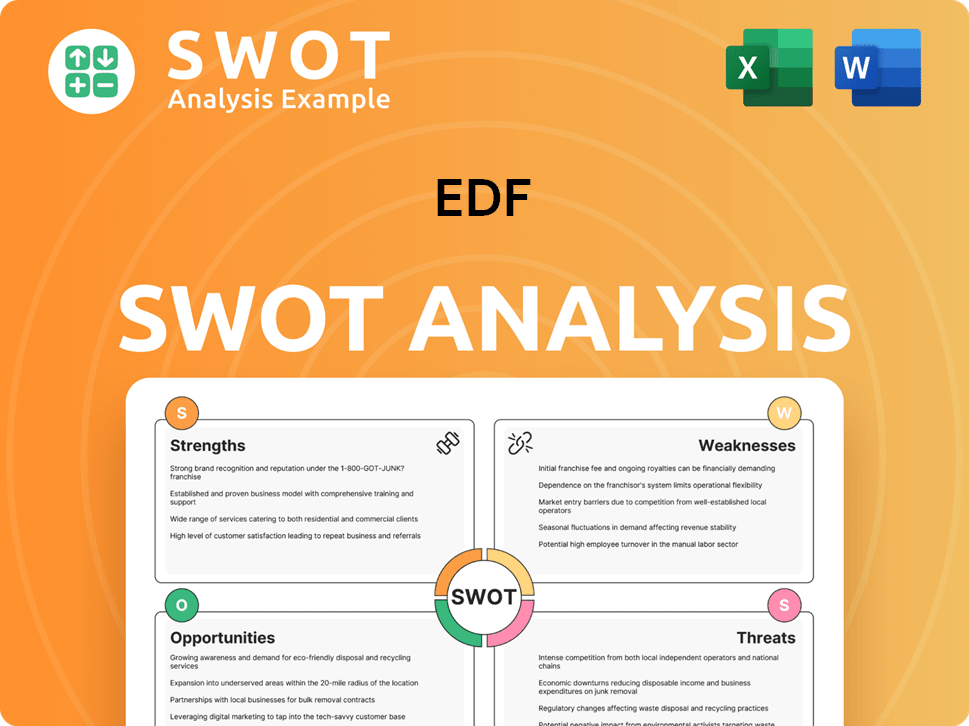
How Does EDF Invest in Innovation?
As part of its EDF growth strategy, Electricite de France (EDF) heavily invests in innovation and technology, especially as the world transitions to cleaner energy sources. This commitment is crucial for the company's EDF future prospects, ensuring it stays competitive in the evolving energy market trends.
EDF's approach involves significant Research and Development (R&D) spending. This supports advancements in nuclear power, renewable energy, and digital technologies. The company continually seeks to improve its operations and adapt to the changing demands of the energy sector, which is a key aspect of any thorough EDF company analysis.
The company's focus on digital transformation is another important element. Initiatives aim to optimize grid management, boost operational efficiency, and enhance customer experiences. This includes using smart meters, AI, and big data analytics for predictive maintenance in power plants.
EDF is developing next-generation EPR (European Pressurized Reactor) designs and Small Modular Reactors (SMRs). These advancements aim to improve safety, efficiency, and flexibility in nuclear power generation. This contributes to the future of nuclear power in EDF.
The company is deploying smart meters and using AI and big data analytics. These tools help with predictive maintenance in power plants and enhance the overall efficiency of operations. This is part of how EDF is adapting to energy transition.
EDF is actively involved in developing and integrating hydrogen technologies. They are exploring the potential of hydrogen in industrial applications and energy storage. This is a key part of EDF's sustainability initiatives.
EDF is pursuing sustainable solutions, such as carbon capture and storage technologies. These efforts aim to reduce the environmental impact of operations. This is related to EDF's investment in renewable energy projects.
EDF's R&D investments support in-house expertise and collaborations with research institutions and startups. This collaborative approach helps drive innovation. This is a key element of EDF's strategic plan for expansion.
Data-driven operations are central to EDF's strategy. The company focuses on optimizing energy production and distribution networks. This includes using AI and big data. For more details, see Revenue Streams & Business Model of EDF.
EDF's innovation strategy focuses on several key areas to ensure its long-term growth. These initiatives are crucial for navigating the challenges and opportunities within the renewable energy sector and the broader energy market.
- Advanced Nuclear Technologies: Developing next-generation EPR designs and SMRs to improve safety and efficiency.
- Digital Transformation: Implementing smart grids, AI, and big data analytics for improved grid management and operational efficiency.
- Hydrogen Technologies: Exploring the potential of hydrogen as a future energy carrier, including its use in industrial applications and energy storage.
- Sustainable Solutions: Investing in carbon capture and storage technologies to reduce environmental impact.
EDF PESTLE Analysis
- Covers All 6 PESTLE Categories
- No Research Needed – Save Hours of Work
- Built by Experts, Trusted by Consultants
- Instant Download, Ready to Use
- 100% Editable, Fully Customizable
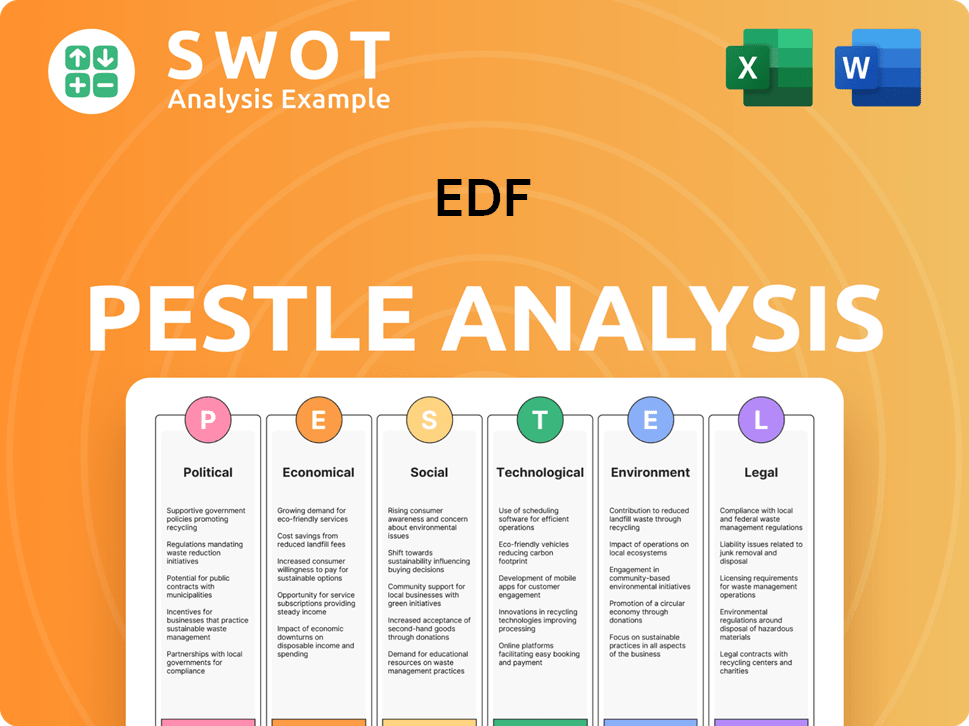
What Is EDF’s Growth Forecast?
The financial outlook for Electricite de France (EDF) is closely tied to its strategic initiatives in low-carbon energy and operational efficiency. Recent financial performance has been influenced by factors such as fluctuating wholesale energy prices and regulatory interventions. However, with the full renationalization by the French state, EDF is expected to gain greater financial stability and capacity for long-term investments. This strategic shift is crucial for supporting the company's ambitious goals in the evolving energy market.
For 2024, EDF has projected an EBITDA range, indicating a focus on improving profitability after a period of challenges. The company's investment plan over the coming years is substantial, reflecting its targets for renewable energy development and nuclear fleet maintenance and expansion. These investments are key to ensuring EDF's long-term competitiveness and contribution to the energy transition. Understanding the Mission, Vision & Core Values of EDF provides further context to its strategic direction.
EDF aims to strengthen its balance sheet and improve its debt profile to support its growth ambitions. Analyst forecasts generally point towards a recovery in financial performance as energy markets stabilize and strategic projects come online. The company's long-term financial goals are aligned with its commitment to the energy transition, aiming for sustainable growth driven by its low-carbon generation assets. Capital raises and potential divestments of non-core assets may also be part of the financial strategy to fund key growth initiatives and manage debt levels effectively.
EDF's growth strategy heavily relies on investments in renewable energy projects, including solar, wind, and hydropower. These investments are essential for diversifying its energy portfolio and reducing its carbon footprint. The company is also focusing on maintaining and expanding its nuclear fleet, which remains a significant part of its generation capacity.
Analysts predict a recovery in EDF's financial performance as energy markets stabilize and strategic projects come online. The company's EBITDA projections for 2024 reflect a focus on improving profitability. EDF's financial outlook is also influenced by its ability to manage debt levels and secure funding for its growth initiatives.
EDF's financial results are sensitive to energy market trends, including wholesale energy prices and regulatory changes. The company is adapting to the energy transition by investing in low-carbon technologies and improving operational efficiency. The shift towards renewable energy and the phasing out of coal-fired power plants are key drivers.
EDF faces challenges such as fluctuating energy prices, regulatory interventions, and the need for significant capital investments. Opportunities include the growth of the renewable energy sector, the potential for international expansion, and the development of smart grid technologies. These factors will shape EDF's future prospects.
EDF's long-term growth potential is underpinned by its strategic investments in low-carbon energy sources and its commitment to the energy transition. This includes significant investments in renewable energy projects and the modernization of its nuclear fleet. The company's focus on innovation, such as smart grids, will further enhance its market position.
- Renewable Energy Expansion: EDF is significantly increasing its investments in solar, wind, and hydropower projects to diversify its energy portfolio.
- Nuclear Fleet Modernization: EDF is investing in the maintenance and potential expansion of its nuclear power plants, which provide a stable source of low-carbon energy.
- International Expansion: EDF is exploring opportunities for international expansion, particularly in the renewable energy sector, to diversify its revenue streams.
- Smart Grid Development: EDF is investing in smart grid technologies to improve energy efficiency and grid management.
EDF Business Model Canvas
- Complete 9-Block Business Model Canvas
- Effortlessly Communicate Your Business Strategy
- Investor-Ready BMC Format
- 100% Editable and Customizable
- Clear and Structured Layout
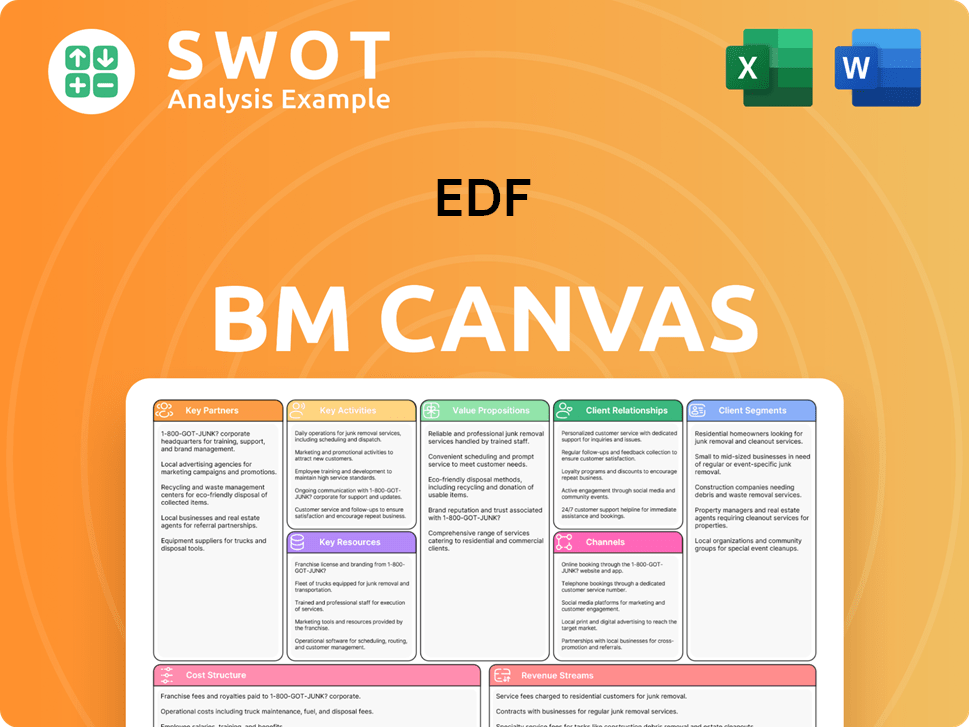
What Risks Could Slow EDF’s Growth?
The EDF growth strategy is subject to several potential risks and obstacles that could impact its future prospects. These challenges span market dynamics, regulatory changes, and operational hurdles. Understanding these risks is crucial for assessing the EDF company analysis and its long-term viability.
Competition within the renewable energy sector and from established players poses a continuous threat to Electricite de France. Regulatory changes, especially in the evolving European energy market, can significantly affect profitability and investment decisions. Supply chain vulnerabilities, particularly for critical components in nuclear and renewable energy projects, can lead to project delays and cost overruns.
Technological disruption and internal resource constraints further complicate the landscape. Adapting to emerging innovations and securing skilled labor are critical for maintaining a competitive edge. The company's ability to navigate these risks will determine its success in the global energy market. For a deeper dive into how the company approaches its marketing efforts, consider reading about the Marketing Strategy of EDF.
Competition from new entrants in the renewable energy sector and established players presents a significant challenge. This competition can impact EDF's market share in Europe and its ability to secure new projects. The competitive landscape analysis reveals a dynamic environment requiring constant adaptation and innovation.
Changes in carbon pricing mechanisms and renewable energy subsidies can significantly affect EDF's financial performance forecast. Regulatory uncertainty can delay investments and impact the profitability of existing projects. The energy market trends are heavily influenced by these regulatory shifts.
Supply chain disruptions, especially for critical components in nuclear and renewable energy projects, can lead to project delays and cost overruns. The global supply chain disruptions experienced in recent years have highlighted this risk. These vulnerabilities can impact the timely completion of projects.
Failure to adapt quickly to emerging innovations or if new, more efficient energy technologies displace its existing assets poses a risk. This necessitates continuous investment in research and development and a willingness to embrace new technologies. The EDF's challenges and opportunities are closely tied to its technological agility.
The availability of skilled labor for complex nuclear and renewable projects could impede growth. Securing and retaining a qualified workforce is critical for project execution and operational efficiency. Addressing these constraints is essential for EDF's long-term growth potential.
Challenges related to the performance of its nuclear fleet and industrial action demonstrate the need for resilient operational strategies. These challenges highlight the importance of robust risk management and contingency planning. The EDF's strategic plan for expansion must account for these operational realities.
EDF addresses these risks through a comprehensive risk management framework. This includes diversifying its energy mix, conducting scenario planning for different market and regulatory environments, and investing in robust cybersecurity measures. These proactive measures are vital for mitigating potential disruptions and ensuring operational resilience. The company's approach reflects its commitment to adapting to the energy transition.
Impact of climate change on EDF is significant, influencing its operations and strategic decisions. The company is investing heavily in renewable energy and sustainability initiatives to reduce its carbon footprint and adapt to climate-related risks. These initiatives are integral to EDF's sustainability initiatives and its long-term viability. The company has set targets to reduce its carbon emissions by 40% by 2030.
EDF Porter's Five Forces Analysis
- Covers All 5 Competitive Forces in Detail
- Structured for Consultants, Students, and Founders
- 100% Editable in Microsoft Word & Excel
- Instant Digital Download – Use Immediately
- Compatible with Mac & PC – Fully Unlocked
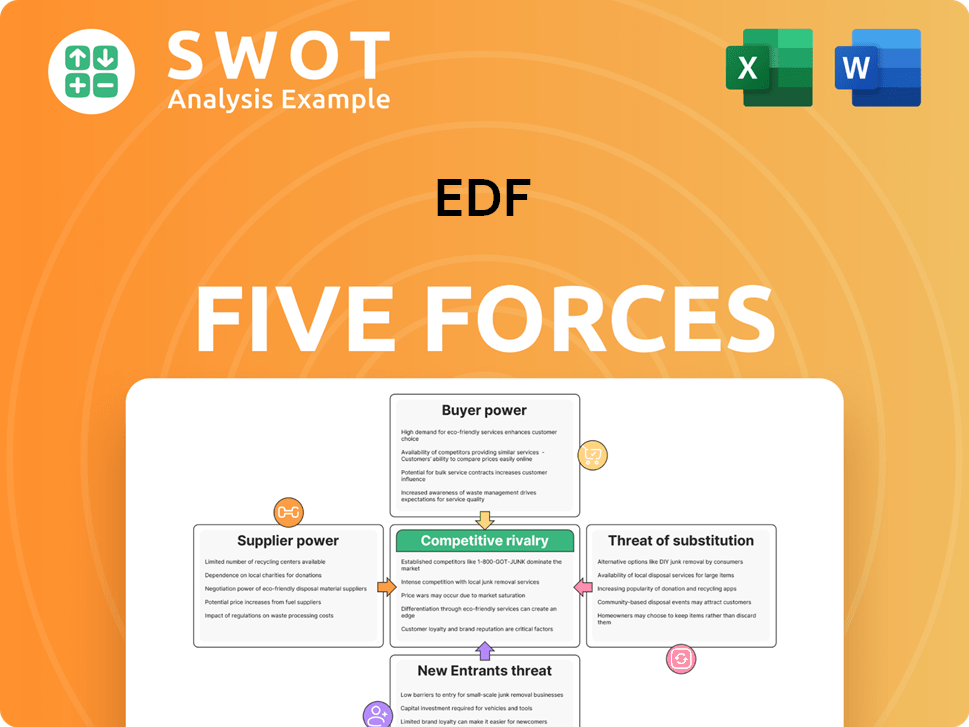
Related Blogs
Disclaimer
All information, articles, and product details provided on this website are for general informational and educational purposes only. We do not claim any ownership over, nor do we intend to infringe upon, any trademarks, copyrights, logos, brand names, or other intellectual property mentioned or depicted on this site. Such intellectual property remains the property of its respective owners, and any references here are made solely for identification or informational purposes, without implying any affiliation, endorsement, or partnership.
We make no representations or warranties, express or implied, regarding the accuracy, completeness, or suitability of any content or products presented. Nothing on this website should be construed as legal, tax, investment, financial, medical, or other professional advice. In addition, no part of this site—including articles or product references—constitutes a solicitation, recommendation, endorsement, advertisement, or offer to buy or sell any securities, franchises, or other financial instruments, particularly in jurisdictions where such activity would be unlawful.
All content is of a general nature and may not address the specific circumstances of any individual or entity. It is not a substitute for professional advice or services. Any actions you take based on the information provided here are strictly at your own risk. You accept full responsibility for any decisions or outcomes arising from your use of this website and agree to release us from any liability in connection with your use of, or reliance upon, the content or products found herein.